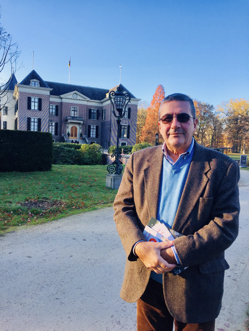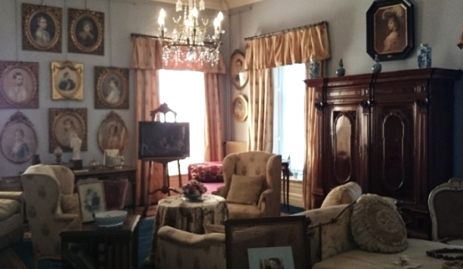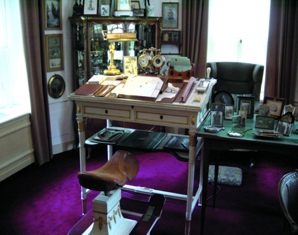On a recent sunny afternoon—a wonderful rarity in Holland’s late fall—I visited Huis  Doorn, the country manor 15 miles east of Utrecht where Kaiser Wilhelm II Hohenzollern spent just over two decades in exile before dying there in early June 1941. His lead coffin, draped in the Imperial flag, lies in the middle of a modest mausoleum on the 150-acre estate.
Doorn, the country manor 15 miles east of Utrecht where Kaiser Wilhelm II Hohenzollern spent just over two decades in exile before dying there in early June 1941. His lead coffin, draped in the Imperial flag, lies in the middle of a modest mausoleum on the 150-acre estate.
The house, completely rebuilt in the late 19th century, is by no means grand, especially when compared to the residences Wilhelm had left behind, or even to the palatial abodes of the captains of German industry (like the Krupps’ Villa Hügel, my next stop come Wednesday). On the outside Huis Doorn has simple, clear lines. On the inside it is comfortable enough, but neither warm nor elegant. It is not popular with visitors, and the Dutch royal family has stepped in to keep the museum afloat.
Initially the Kaiser spent a year and a half as a guest of Count Godard van Aldenburg- Bentinck at his château Amerongen, a few miles east of Doorn. When it became obvious that returning to Berlin and reclaiming the throne was not an option, he bought the house from Baroness Ella van Heemstra, the mother of Audrey Hepburn.
Bentinck at his château Amerongen, a few miles east of Doorn. When it became obvious that returning to Berlin and reclaiming the throne was not an option, he bought the house from Baroness Ella van Heemstra, the mother of Audrey Hepburn.
The new government in Germany—which he heartily despised, calling it Saurepublik—was generous to Wilhelm, providing him with the means to keep 40 staff on the payroll and die a wealthy man. In addition, between September 1919 and February 1922, the Weimar authorities approved dispatch of five trains with 62 carriages filled with Wilhelm’s possessions—paintings, furniture, objets d’art, massive carpets, uniforms, silverware and all sorts of bric-a-brac—from various palaces in Germany to the nearby station at Driebergen-Zeist.
The house could accommodate only a fraction of the pile. Most of it has remained in storage ever since. The goods were confiscated by the Dutch state in 1946, like the estate itself, which opened its doors to the public as a historic house museum in 1956. To this day it remains unchanged, just as the Kaiser left it when he died, which is its most commendable quality. The rooms are filled with marquetry commodes, tapestries, oils by German court painters, and lots of porcelain and silver. The display also includes Wilhelm’s collections of snuff boxes and watches which belonged to Frederick the Great.

The lots that remain stored may yet yield a pretty penny for the Dutch state at Christie’s or Sotheby’s, but probably far less than a single painting by van Gogh or Rembrandt would. From what is on display . . . personally, not a single item elicits excitement. The house is a 1920’s relic of the Edwardian era, interesting primarily for the glimpse it gives us into the psyche and taste of its chief occupant. It is fastidiously vulgar, devoid of even a hint of connoisseurial discernment.
 If taste reflects class, as I believe it does, the Kaiser was a staid bourgeois prone to opulence but devoid of elegance. “Less is more” was unknown at Doorn. Many furnishings are oversized for the rooms’ modest dimensions. The walls, mantle pieces, tables and dressers are painfully cluttered. Much of the stuff, especially china, is borderline kitsch. (And a few horrid, mind-bogglingly busy, angel-infested chandeliers go well beyond “borderline.”)
If taste reflects class, as I believe it does, the Kaiser was a staid bourgeois prone to opulence but devoid of elegance. “Less is more” was unknown at Doorn. Many furnishings are oversized for the rooms’ modest dimensions. The walls, mantle pieces, tables and dressers are painfully cluttered. Much of the stuff, especially china, is borderline kitsch. (And a few horrid, mind-bogglingly busy, angel-infested chandeliers go well beyond “borderline.”)
A visit to Wilhelm’s mini-court in exile is not rewarding in the sense a visit to Hatfield House is. It nevertheless helps us understand the tragedy that befell Europe in July 1914. This is the Kaiser’s microcosm at its unadulterated self: cluttered, arid, and finally repulsive in its coarse banality. Small as it is, Huis Doorn oozes the distilled Stimmung of the grander palaces in Berlin, Potsdam, and other properties which the Kaiser had inhabited before that tragic summer.
The main contours of the tragedy of 1914 are no longer contentious among leading academic historians. (This excludes poorly educated media scribes, who still peddle the myth that the war was the result of unintended blunders, and charlatans like Christopher Clark whose Sleepwakers is a pamphlet masquerading as history.) As Germany’s foremost historian of the 20th century, Fritz Fischer, established in his definitive 1961 study Griff nach der Weltmacht (Germany’s Aims in the First World War), the Kaiserreich military and political elite welcomed the prospect of war resulting from Sarajevo as an opportunity to make Germany the master of Europe. About a dozen Germans (and four or five Habsburg subjects as secondary players) conspired to engineer this outcome; the Kaiser was the chief culprit.
Over the previous quarter-century Wilhelm strutted awkwardly on the European stage, looking ridiculous at times (e.g. when riding into Tangier in March 1905), making histrionic scenes (notably at his grandmother Victoria’s funeral), managing to alienate erstwhile German friends (Britain), turn former allies into foes (Russia), and old foes into implacable enemies (France). An insecure neurotic, Wilhelm routinely blamed others for his failings—or else retreated into depressive self pity when the blame was manifestly his.
The son of Queen Victoria’s eldest daughter of the same name (“Vicky”) and Crown Prince Friedrich of Prussia, Wilhelm was born in 1859 with a disability which fatally marked his life. His left arm was left paralyzed and withered as a result of complicated birth. The damage was probably caused by the forceps which dragged him out. Born blue, he was initially presumed dead and only brought round by vigorous rubbing which may have made the nerve damage worse. It has often been speculated that oxygen deprivation at birth resulted in minor brain damage, which may explain the unstable personality for which he would become infamous.
Much of Wilhelm’s early years were spent enduring grotesque yet useless treatments, from having a freshly killed hare wrapped around his arm to an early form of “electrotherapy” (i.e. shocks) and macabre-looking metal restraints to keep his posture upright. The bodily defect, which his mother found repugnant (“that deadweight hand, like a claw”), deeply affected the boy’s early formation.
According to the Kaiser’s foremost biographer John Röhl, the teenage prince was fixated on winning his mother’s love which was conspicuously absent. Professor Röhl has discovered letters in the papers of Vicky’s great-grandson Prince Rainer of Hesse, showing the youngster’s erotic longing for his mother. To wit, “I have been dreaming about your dear soft, warm hands, I am awaiting with impatience the time when I can sit near you and kiss them but pray keep your promise you gave me always to give me alone the soft inside of your hand to kiss, but of course you keep this as a secret for yourself.” There are several others in a similar vein.
By the time Wilhelm ascended the throne at the age of 28, however, his feelings for his mother had turned into intense hostility. Two years later he removed Bismarck as Chancellor, started his pursuit of Weltpolitik, and duly turned the German foreign policy into a force deeply destabilizing to peace in Europe. Bismarck’s Reinsurance Treaty with Russia was not renewed, resulting in an ostensibly unnatural alliance between the liberal, Masonic, secular and republican France and the Orthodox Christian, conservative, autocratic Russian Empire. Germany was in the middle, reinforcing Wilhelm’s obsession with “encirclement.” That did not stop him initiate a massive naval building program, which was certain to alienate Britain.
The details of all that are provided in John Röhl’s massive, superb and depressing Wilhelm II: Into the Abyss of War and Exile, 1900-1941. It takes the reader, relentlessly, through every gust of enthusiasm, bravado or rage that happened to grip the Kaiser at any given moment. Reading at length his own private and official letters and marginalia, we can grasp why so many people who knew him, at home and abroad, saw the Kaiser as unstable, infantile, belligerent, domineering, silly, and above all dangerous.
Under the Imperial constitution rather carelessly bequeathed by the Iron Chancellor to his successors, Wilhelm as Emperor enjoyed executive power over foreign, military and naval policy of the Reich. He exercised that power with gusto, frequently bypassing his civilian officials—from the Chancellor downwards—and accusing the Foreign Ministry of cowardice whenever it advised caution. Needless to add, he loathed the Reichstag and ignored it whenever possible. It is clear beyond reasonable doubt that the Kaiser, more than any other individual, created the atmosphere in Berlin which made the war after Sarajevo very likely, if not inevitable.
Fast forward to the night of November 9-10, 1918. The German army is no longer  capable of fighting and no longer loyal to the “All-Highest.” The Kaiser is presented the facts by his generals, who know that the armistice must be signed and a new government formed right away to preempt the revolution. General Wilhelm Groener, Ludendorff’s replacement at the helm of the general staff, tells Wilhelm that the army would not fight to keep him on the throne. Visibly ill at ease, the ever-Kaisertreu Marshal von Hindenburg spoke next, advising his sovereign to give up the crown. (In practice this meant both crowns, the imperial one of Germany and the royal crown of Prussia, which initially Wilhelm wanted to keep.)
capable of fighting and no longer loyal to the “All-Highest.” The Kaiser is presented the facts by his generals, who know that the armistice must be signed and a new government formed right away to preempt the revolution. General Wilhelm Groener, Ludendorff’s replacement at the helm of the general staff, tells Wilhelm that the army would not fight to keep him on the throne. Visibly ill at ease, the ever-Kaisertreu Marshal von Hindenburg spoke next, advising his sovereign to give up the crown. (In practice this meant both crowns, the imperial one of Germany and the royal crown of Prussia, which initially Wilhelm wanted to keep.)
Following secret negotiations with Queen Wilhelmina and the Dutch government, in the early hours of November 10 a dismayed, disheartened Wilhelm left the Imperial Headquarters at Spa with a small entourage and crossed the nearby Belgian-Dutch border at Eijsden. He was never to leave the Netherlands again, despite the (mostly half-hearted) attempts of the victors to bring him to trial as a war criminal. Anticipating the “crime against peace” offense at Nuremberg in 1946, Article 227 of the Treaty of Versailles provided for the prosecution of Wilhelm “for a supreme offence against international morality and the sanctity of treaties.” Queen Wilhelmina and the Dutch government refused the Allies’ extradition requests, however. King George V agreed. He wrote that his cousin was “the greatest criminal in history,” but opposed Prime Minister David Lloyd George’s election slogan “Hang the Kaiser!” President Woodrow Wilson also opposed extradition, arguing that punishing him would destabilize postwar order.
Wilhelm was safe but unhappy. The exile was forced on him: he was certainly no martyr who had sacrificed himself for the sake of his people, nor did he willingly accept the role of a scapegoat so that the Reich might live. Empress Augusta Victoria died at Huis Doorn in April 1921, her heart worn out by the shock of abdication and its aftermath, and by the 1920 suicide of their youngest son Joachim. Wilhelm had 150 acres of the surrounding grounds to roam at will and chop wood (his favorite pastime), but he could not venture freely beyond 15 miles from the estate. According to his physician Alfred Haechner, he started feeling depressed and lonely.
Haechner suggested inviting “varied and interesting guests for the Kaiser to talk to.” Huis Doorn soon became the scene of an indecorous procession of potentially eligible women of various ages and social backgrounds who were hoping to insinuate themselves into the 62-year-old widower’s confidence and, eventually, into nuptial bed. In his essay on the Kaiser in exile (The Unicorn in Winter, 2011) John Röhl lists no fewer than ten contenders. They included a Finnish woman, Dr. Hammar, who claimed to have the power of foresight (and yes, she predicted the Kaiser would return to the German throne), as well as two Hungarian sisters with fiery temperaments who “also left a deep impression.” Princess Luise zu Solms, Ittel von Tschirschky, Erbprinzessin Marie Christine zu Salm-Salm, Catalina von Pannwitz and Gabriele von Rochow all tried their luck. There was also the 26-year-old Lili van Heemstra, from whose aunt Wilhelm purchased the estate and to whom he wrote an explicit letter suggesting she should become his mistress.
To everyone’s surprise, Wilhelm chose a widow with five children, Princess Hermine Reuss of Greiz, whom he had never met before she was invited to visit in June 1922. Their engagement was announced two days later. As per Röhl it was a shocking mesaillance, but despite grumblings from Wilhelm’s monarchist supporters and the objections of his children, 63-year-old Kaiser and 34-year-old Hermine married on November 5, 1922, in Doorn. By all accounts Hermine was unpleasant, nervous, domineering, and unabashedly ambitious: she demanded to be addressed as “Your Majesty,” to the dismay of Wilhelm’s family and the ever-dwindling band of supporters back home. Nevertheless, she seemed to suit the bitter old woodchopper just fine; after his death in 1941 she returned to Germany, dying soon after the war in the Soviet zone.
In the end, there was nothing noble or edifying about the Kaiser in his 23 years of Dutch exile. In late exile he cut an awkward, almost pathetic figure. Far from growing introspective with age, he cultivated or intensified the hatreds and prejudices which informed his actions while in power. As Röhl says, he “scapegoated all those he blamed for his disastrous reign: not just the English and the French, the Americans and the Bolsheviks, but the German people, the Austrians, the Catholic church, the Jesuits, the Freemasons, and of course—over and over again and in murderously ferocious terms—the Jews . . . His only real quarrel with the Führer was that Hitler would not restore him to the throne.”
I was glad to take leave of Huis Doorn’s suddenly gloomy grounds at dusk. I felt anger, rather than sorrow, that a man as hollow, petty, mean, pompous, foolish, ignorant, unstable, as devoid of human qualities as Kaiser Wilhelm II was, could have the power to inflict so much damage—on his own people, on Europe, on the world, and ultimately on a fine civilization which was wrecked for ever in the trenches.
It is a matter of some regret to me that Wilhelm did not live four more years to see the final Untergang of the destructive Furor Teutonicus, the catastrophe which he helped unleash, more than any other man, in the summer of 1914. But we are not done with him yet. Nein, Wilhelm! Wir sind noch lange nicht fertig . . .
Leave a Reply